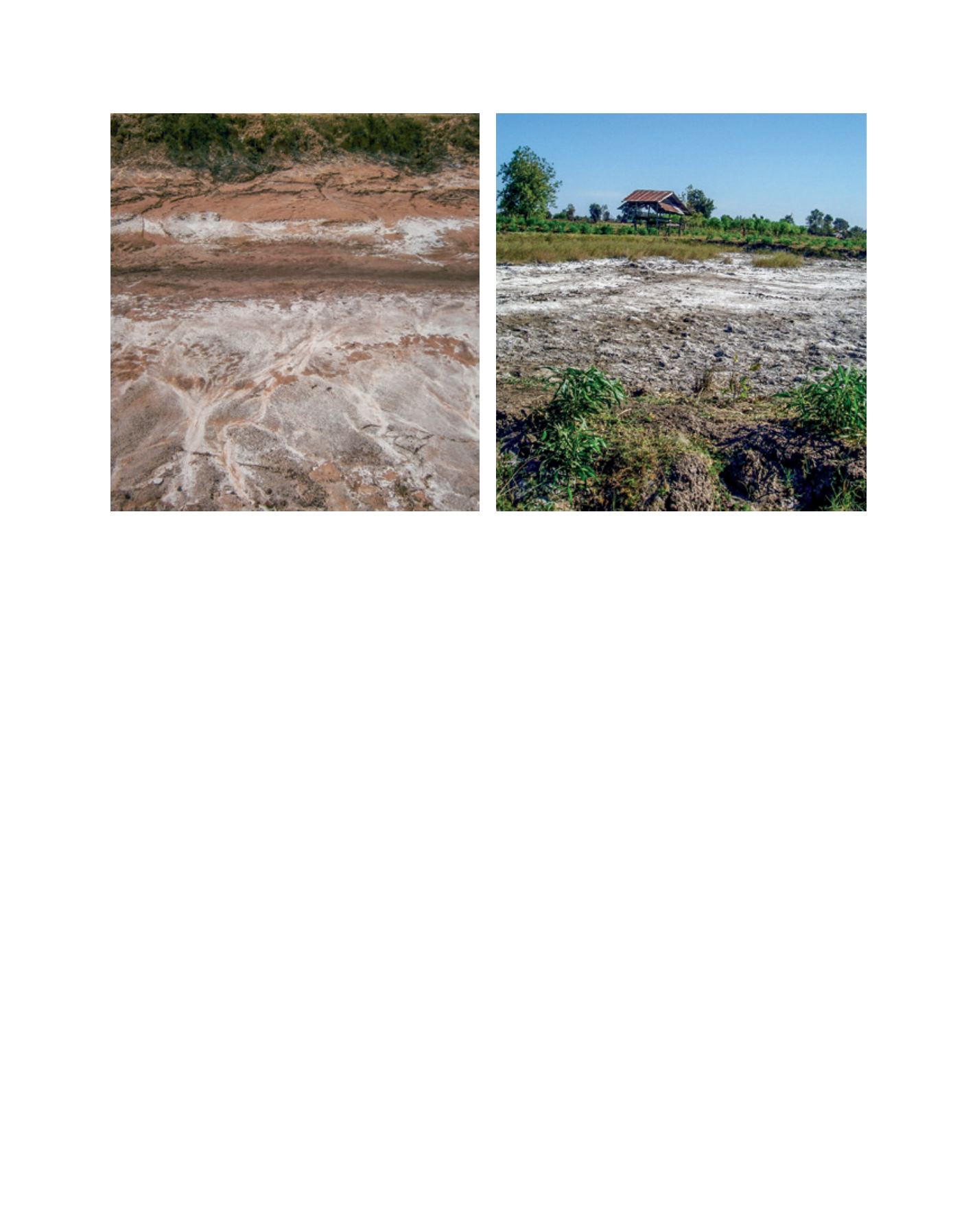

[
] 49
The approach used to improve saline soil begins with provid-
ing knowledge to farmers on how to use rainwater to leach
saline in paddy fields. This entails storing water in paddy fields
for two to three days until its colour turns brown, then discharg-
ing the water to the installed drainage system. After repeating
the same leaching step two or three times, the farmers can
grow paddy as usual. LDD also recommends that farmers use
organic substances such as rice husk, compost and farmyard
manure together with green manure such as
Sesbania rostrata
to incorporate into the soils after harvesting for 100-120 days
to increase organic matter, help retain moisture in the soil and
prevent upward migration of saline to the soil surface by capil-
lary water. To reduce utilization of chemical fertilizers and
ensure the use of organic substances, LDD promotes the use
of microbial activators in making composts and liquid ferti-
lizers for the improvement of saline soil on individual farms.
Agricultural residues are locally available for this purpose.
Thus, saline soil will be improved through leaching out the
saline and increasing organic matter in the soil.
Rehabilitating saline soils takes time. Salinity levels will not
decrease much in the first and second year, so a better yield
cannot be fully expected in this period. Apart from the focus
on technical and biophysical aspects of saline soil rehabilitation,
the area approach has been used to implement the project, and
its potential to improve farmers’ incomes and sustainable liveli-
hoods has been considered. Therefore, farmers in the reclamation
areas receive technical assistance and other support from various
government agencies and institutions including local govern-
ment and the private sector. The concept of participatory saline
soil management has been introduced, with LDD as the main
agency that coordinates and works with other relevant partners
in the area. The partners have a shared goal to increase rice
productivity and enhance the value added to rice products in
order to raise farmers’ income in the project area. Biophysical
rehabilitation helps to improve soil properties and the capac-
ity for rice production, while other supporting activities from
partner agencies contribute to increasing knowledge of other
development techniques, such as rice production techniques to
achieve premium-grade rice with a unique aroma when cooking,
as well as marketing. As a result farmers’ incomes have increased.
Participatory actions have been introduced since the first year
of the rehabilitation project. Apart from soil improvement gained
from applying green manure crops (
Canavalia ensiformis
or Jack
Bean) and growing
Sesbania
on paddy field dykes, farmers also
earn additional income from selling seeds. SCG Paper, a public
limited company taking part in the project, supports the provi-
sion of seedlings of eucalyptus, a fast-growing and salt-tolerant
tree species, to farmers. After a period of three to three-and-a-half
years, the trees can be harvested and sold to the company for
about B22,000 per rai (6.25 rai = 1 hectare).
At the very beginning, though the rehabilitation project was
taking place, the rice yield was apparently very low. Productivity
was only about 300-320 kg/rai while the cost of production was
as high as B4,600 per rai. Instead of gaining profit, farmers lost.
The question was how to improve both production and the price
of the rice. Then LDD coordinated with the National Science and
Technology Development Agency (NSTDA) and provided capac-
ity-building to farmers on improving rice yield and quality. The
training focused on soil and seed-bed preparation; identification
and selection of good quality, salt-tolerant rice seeds; appropriate
growing techniques and water management; harvesting and post-
harvest techniques; rice-mill processing for good quality grains,
and packaging. Under the training programme, farmers gained
more knowledge about saline soil improvement and techniques
for quality rice production. Additionally, many workshops had
been organized by NSTDA to identify and select groups of skilled
LDD works with farmers to rehabilitate saline soil, which covers 29 per cent of the area of north-eastern Thailand
Images: LDD
L
iving
L
and
















